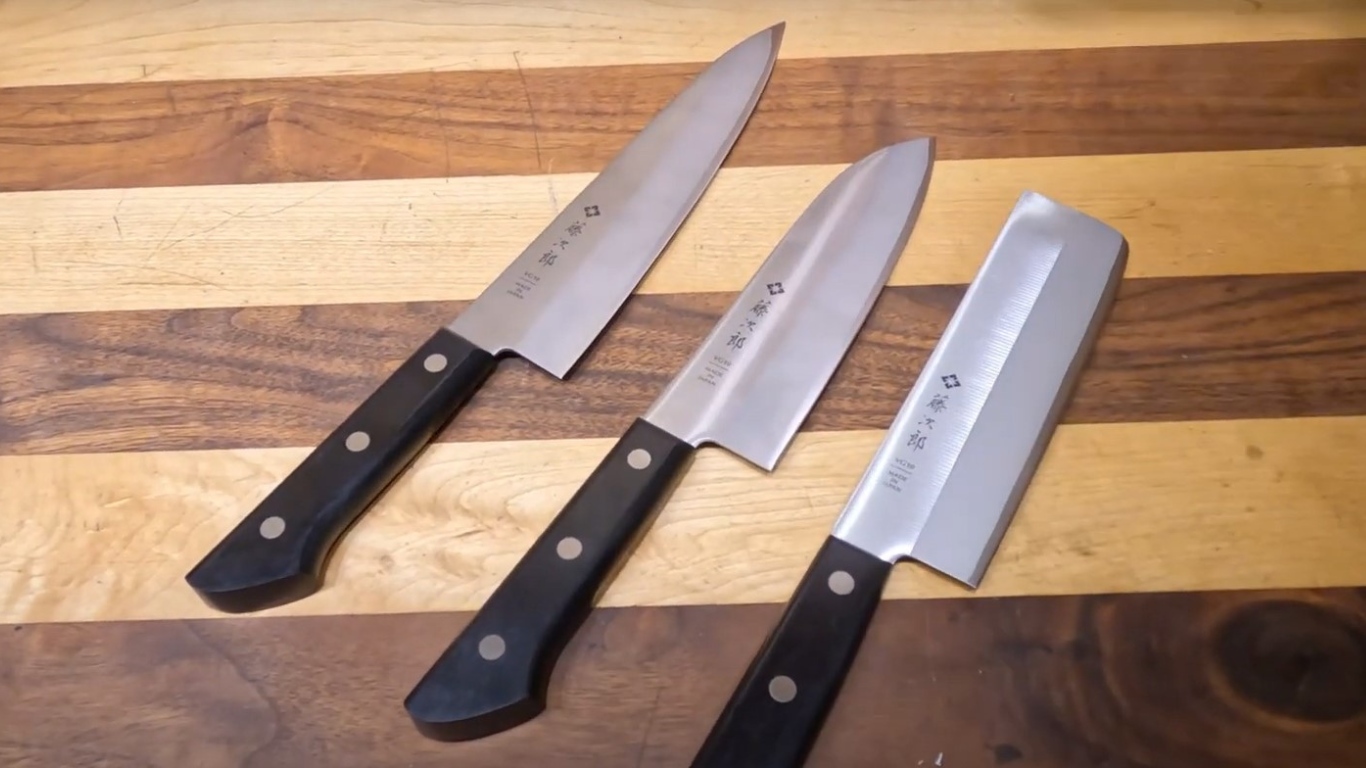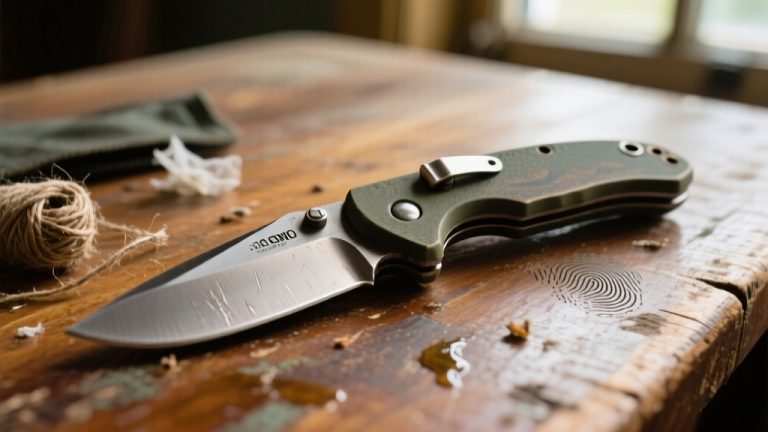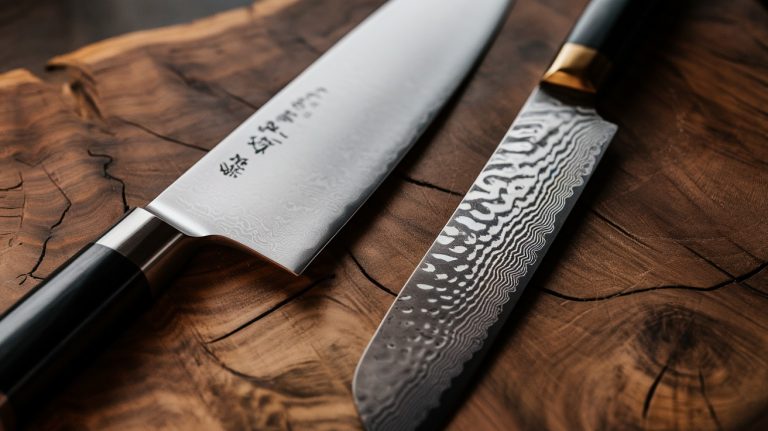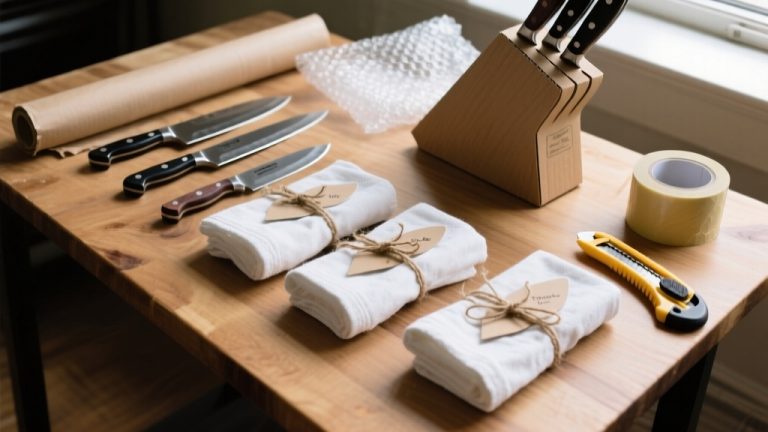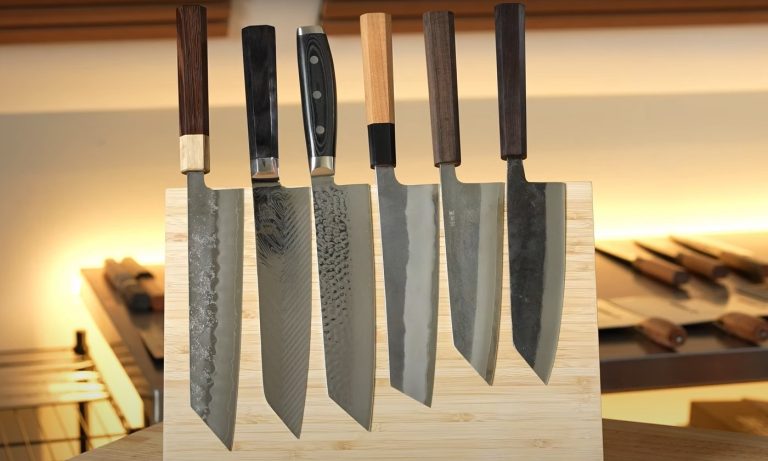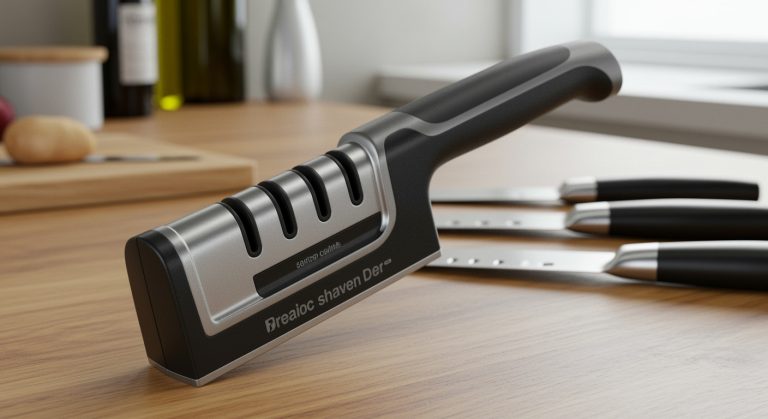Tojiro Dp vs Basic: Which Knife Cuts It in Your Kitchen?
When comparing Tojiro DP and Basic knives, you’ll notice key differences. The DP line features VG-10 steel with a full tang, stainless steel bolster, and durable Micarta handle, offering a heavier, balanced feel at 191-204g for a 210mm gyuto.
The Basic line, with its partial tang and lighter Pakkawood handle, weighs just 127-135g, prioritizing agility. Both deliver sharp, lasting edges, but their design suits varied tasks. Stick around to uncover deeper insights.
Tojiro Knife Lines Overview
The renowned Tojiro brand, hailing from Tsubame-Sanjo, Niigata, Japan, offers a diverse array of knife lines that blend machine precision with hand craftsmanship, delivering exceptional cost-to-performance ratios. These knives often feature high-carbon stainless steel for enhanced sharpness and longevity.
Originating from Tsubame-Sanjo, Niigata, Japan, Tojiro masterfully combines machine precision and hand craftsmanship, offering knife lines with outstanding cost-to-performance value.
You’ll find options like the DP Line, their flagship series with Western-style handles in black composite or stamina wood, ideal for home cooks and pros seeking value.
The Basic Line, a budget-friendly choice, features lighter handles without bolsters, yet matches DP’s performance closely.
For professionals, the Pro Line offers metallic, hygienic handles with unique “tornado” grip patterns. Additionally, Tojiro’s Classic Line provides a wide range of knives, from Santoku to Gyuto, catering to various cutting needs with premium quality Classic Line variety.
If you prefer traditional designs, explore the Japanese-style lines like Shippu or Zen Black, showcasing wa-handles in magnolia or burnt chestnut and classic shapes like Yanagiba or Deba for specialized tasks.
Blade Composition and Durability
As you examine the blade composition of Tojiro DP and Basic knives, you’ll notice both utilize VG-10 core steel, a high-carbon stainless alloy from Takefu Special Steel Co., boasting exceptional hardness and edge retention at HRC 60-61.
You’ll also find that their 3-ply San Mai construction, with softer 13-Chrome stainless steel cladding, enhances durability and corrosion resistance while protecting the hard core. This design provides better corrosion resistance compared to carbon steel knives.
This construction method ensures that both knives maintain exceptional sharpness over time, making them reliable choices for professional chefs.
Let’s explore how these shared traits in steel core and clad layer strength impact their overall performance and longevity.
Steel Core Comparison
Dive right into the heart of Tojiro’s craftsmanship with a look at the steel core in both the DP and Basic lines, where you’ll find the renowned VG-10 stainless steel from Takefu Special Steel Co., Ltd.
This high-carbon steel, with 0.95-1.05% carbon and 14.0-15.5% chromium, offers superb corrosion resistance. This durability is akin to that found in high-carbon stainless steel used in brands like Hoshanho.
Cobalt (1.30-1.50%) and vanadium (0.10-0.50%) enhance strength and wear resistance, while molybdenum (0.90-1.20%) boosts toughness.
Both lines achieve a hardness of 60-61 HRC, ensuring excellent edge retention and razor-sharp cuts.
However, VG-10’s hardness can lead to chipping if you misuse it, like striking hard materials.
Thanks to Tojiro’s optimized heat treatment, you’ll notice the VG-10’s durability and fine grain stand out in both series.
Additionally, the DP line features a blade core clad with softer stainless steel for added protection, mirroring the design of the Fujitora FU-885 model clad with softer steel.
Clad Layer Strength
Precision defines the blade composition of Tojiro’s DP and Basic series, where clad layer strength plays a critical role in durability.
You’ll notice that both lines use stainless steel cladding to shield their hard cores—DP with 13-chrome steel and Basic with high-chromium alloys.
This softer outer layer guards against corrosion, absorbs impact, and prevents chipping of the brittle VG10 or molybdenum vanadium cores.
When you compare them, DP’s cladding balances protection with a polished look, while Basic prioritizes rust resistance for practicality.
Both guarantee toughness, though alloy differences might affect scratch visibility.
You’ll find maintenance easier, as cladding reduces stress on the edge and extends blade life, even if sharpening exposes the core over time.
This design enhances edge retention, drawing parallels to steels like SG2 that feature excellent performance due to their high hardness and chromium content.
Handle Design and Comfort
As you compare the Tojiro DP and Basic lines, you’ll notice distinct handle material differences, with the DP featuring a reinforced laminated material like Micarta for durability and smoothness, while the Basic opts for water-repellent pakkawood for hygiene and a lighter touch.
Moreover, the DP often features a full bolster, which contributes to enhanced hand protection and better overall balance in its design.
You’ll also feel how these materials, combined with construction choices like full tang in the DP versus partial tang in the Basic, impact ergonomic weight, making the DP heavier and more balanced toward the handle, while the Basic offers a nimbler, lighter grip.
Consider how these factors influence your comfort and control during extended use in the kitchen. Additionally, the Basic’s handle design prioritizes comfort with a shape that supports a pinch grip near choil for precise control.
Handle Material Differences
When comparing the handle materials of the Tojiro DP and Basic lines, you’ll notice distinct differences in composition and performance.
The DP’s handle, often black micarta or reinforced laminated material, boasts exceptional durability, resisting heat, cold, and wear with a smooth, hard synthetic feel. This makes Micarta an excellent example of synthetic composites, known for their exceptional grip and durability.
In contrast, the Basic’s pakkawood handle, a laminated reinforced wood, offers sturdy construction and water resistance, though it’s lighter and less premium in texture.
Both materials excel in longevity, but retail descriptions sometimes mislabel the DP’s composition, causing confusion. Additionally, the DP line’s handle design mirrors the refined and lengthened style seen across other Tojiro lines, enhancing grip comfort refined handle design.
Check these key points to understand their impact:
- DP’s micarta: Feels solid, withstands harsh conditions.
- Basic’s pakkawood: Lightweight, durable against moisture.
- Material clarity: Verify specs, as retailer info varies.
Ergonomic Weight Impact
How does the handle design affect comfort and performance in the Tojiro DP and Basic lines?
You’ll notice the DP’s Western-style handle, contoured with a stainless steel bolster, offers a secure grip and balanced feel near the handle junction, thanks to its full tang and heavier weight.
Though earlier models had sharper edges, newer ones are often smoother, enhancing comfort.
In contrast, the Basic’s straight slab handle, lacking a bolster, shifts the balance forward with its partial tang, making it lighter and nimbler, reminiscent of a Japanese Wa-handle.
Both use durable materials—DP’s Micarta and Basic’s Pakkawood—ensuring a firm grip. This approach to handle design echoes the full-tang design used in other premium brands for enhanced stability and longevity.
Additionally, the DP series, often weighing around 7.2 oz for an 8-inch gyuto, provides a substantial feel that many chefs find reassuring for extended use weighing around 7.2 oz.
Tang and Bolster Differences
Precision in design sets the Tojiro DP and Basic lines apart when it comes to their tang and bolster construction. These features are characteristic of Japanese knives, which prioritize balance and performance in their construction.
When you examine the DP, you’ll notice its full tang extends through the handle, secured by three stainless steel rivets, paired with an 18/8 stainless steel bolster for a seamless, hygienic blade-to-handle junction.
In contrast, the Basic line’s tang—advertised as full by some, partial by others—features a simpler build, often without a distinct bolster, connecting handle material directly to the blade.
Consider these technical distinctions:
- DP’s bolster adds finger protection and a defined grip.
- Basic’s bolsterless design simplifies sharpening to the heel.
- Tang construction in DP guarantees durability over Basic’s lighter approach.
Additionally, the DP’s bolster provides heft and balance, ensuring a comfortable and controlled cutting experience with every use.
Weight and Balance Comparison
Diving into the weight and balance comparison, you’ll notice stark differences between the Tojiro DP and Basic lines that directly impact their handling.
The DP Gyuto (210mm) weighs 191-204g, considerably heavier than the Basic Gyuto (200mm) at 127-135g, largely due to the DP’s full-tang construction with a bolster versus the Basic’s partial tang.
Weight range for Gyuto knives typically falls between 7 to 18.8 ounces, which the DP aligns with for better control in chopping dense ingredients.
You’ll find the DP’s balance point near the bolster, giving a handle-heavy, Western-style feel, ideal for those used to substantial knives. This design mirrors the DP’s full tang structure, which contributes to its handle-heavy balance.
Conversely, the Basic’s balance shifts slightly forward, offering a nimble, lighter grip akin to Japanese Wa-handles.
The DP suits larger tasks with its heft, while the Basic excels as an agile workhorse for smaller jobs.
Fit and Finish Details
Take a close look at the fit and finish of the Tojiro DP and Basic lines, and you’ll spot clear distinctions in their construction quality.
The DP boasts a full-tang design with a stainless steel bolster, triple-riveted Micarta or Pakka Wood handles, and flush integration, though spine and choil edges might need rounding.
The Basic, however, uses a partial tang, simpler Pakka Wood handles, and lacks a separate bolster, risking small gaps at the blade junction.
Check these details to understand their craftsmanship:
- DP’s Bolster: Adds heft and prevents dirt buildup.
- Basic’s Simplicity: Functional, lightweight, but less refined.
- Edge Comfort: Both may require sanding for smoother spine and choil.
Notice the DP’s superior finish, while the Basic remains practical for its cost.
The Tojiro DP, crafted with harder Japanese steel, offers enhanced edge retention that aligns with the precision demands of gyuto knives.
Grind and Cutting Performance
When examining the grind and cutting performance of the Tojiro DP and Basic lines, you’ll notice both share a VG-10 stainless steel core wrapped in a 3-layer san mai construction, guaranteeing solid edge retention and ease of sharpening.
Exploring Tojiro DP and Basic lines reveals a shared VG-10 stainless steel core in a 3-layer san mai build for exceptional edge retention.
The DP often features convex grinds for better food separation, while the Basic’s thin grinds contribute to a lightweight, nimble feel.
You’ll find the DP’s geometry thinner than Western knives, though not laser-like, with some models sporting a 15-degree V grind per side.
Both lines cut similarly, with the DP offering razor-sharp edges and the Basic excelling for its price.
Out of the box, they’re sharp—DP edges test at 112-119g on BESS, improvable to 59-97g with stropping, while VG-10 guarantees keen, lasting edges.
Target Users and Suitability
Exploring the target users and suitability of the Tojiro DP and Basic lines reveals distinct profiles for each.
If you’re switching from Western knives or need a robust, versatile workhorse, the DP suits you with its heftier Western-style handle and durability for both home and professional kitchens.
Conversely, if you’re a home cook seeking a lighter, minimalist Japanese knife, the Basic line fits with its nimble feel and simpler Pakkawood handle, ideal for tighter spaces or smaller tasks.
Consider these key points to decide:
- DP’s Strength: Perfect if you want a full-tang, bolstered handle for rigorous use.
- Basic’s Agility: Opt for this if you prefer lighter balance and dexterity.
- User Focus: DP for pros and amateurs; Basic for home-focused cooks.
Pricing and Value Assessment
Diving into the pricing and value assessment of the Tojiro DP (now Classic) and Basic series, you’ll notice a clear distinction in their cost structures reflective of their design and target markets.
The Basic line, often under $60 USD, offers VG-10 steel at a steal, prioritizing performance over aesthetics. Meanwhile, the DP/Classic, ranging $65-$120+ USD, justifies its cost with superior fit, finish, and Micarta handles with bolsters.
Check this table to feel the value impact:
| Feature | Basic (Affordable Joy) | DP/Classic (Premium Pride) |
|---|---|---|
| Price | Under $60 | $65-$120+ |
| Steel | VG-10 | VG-10 |
| Handle | Pakkawood, No Bolster | Micarta, Bolster |
| Weight | Lighter, Nimble | Heavier, Robust |
| Finish | Functional | Polished, Professional |
Frequently Asked Questions
Are Tojiro DP Knives Dishwasher Safe?
Hey, are Tojiro DP knives dishwasher safe? Don’t risk it.
Most sources, including retailers and care guides, strongly advise against it due to high heat and harsh detergents that can corrode the VG-10 steel core and damage handles like ECO wood or Pakkawood.
Knives might also chip or dull from banging around.
Stick to hand washing with a soft sponge, neutral detergent, rinse thoroughly, and dry immediately.
Can Basic Series Handles Be Replaced?
You can replace the handles on Basic series knives, but it’s a complex task.
Start by drilling or grinding out the rivets securing the pakkawood scales without damaging the full tang.
Then, shape and fit new handle scales precisely, drill holes for rivets, and peen them to secure everything.
It’s a technical process, so if you’re not experienced, consider hiring a professional for this intricate repair job.
Do DP Knives Require Special Sharpening?
When sharpening knives, note that VG10 steel, often used in premium blades, boasts a hardness of 58-66 HRC, making edges last longer but trickier to hone.
You’ll need whetstones over pull-through sharpeners for precision.
Start with a 1000-grit stone to set the edge, then refine with 3000-8000 grit.
Maintain a consistent 9-12 degree angle per side.
Deburr carefully, as VG10 can form persistent wire edges.
Is the Basic Series Rust-Resistant?
You’re looking into the rust resistance of certain knife series, and it’s important to know the specifics.
With a high chromium content (14.5-15.5%) in the stainless steel, you’ll find these knives resist corrosion well.
The outer layers add extra protection against rust.
However, they’re not stain-proof, so don’t neglect care.
Wash ’em right after use, dry thoroughly, and avoid damp storage to prevent any rust spots from forming.
Are DP Knives Made in Japan?
Hey, let’s cut to the chase—are DP knives made in Japan? You’ll be glad to know that yes, they absolutely are.
Tojiro Co., Ltd. manufactures the DP series in Tsubame-Sanjo, Niigata Prefecture, a renowned metal-processing hub.
Official listings, retailer confirmations like Knifewear, and factory tour videos all verify this.
Using VG-10 steel and San-mai construction, these knives proudly bear the “Made in Japan” mark.
More Than a Knife—It’s a Reflection of Your Kitchen Style
As you weigh your options between Tojiro DP and Basic, remember that each blade is a double-edged sword—offering unique strengths and trade-offs.
If you’re seeking precision with superior steel, go for the DP’s VG-10 core. If budget and reliability are your focus, the Basic’s sturdy build won’t let you down.
Assess your cutting needs, grip preferences, and wallet. Choose wisely, and you’ll wield a tool tailored to your kitchen craft.

